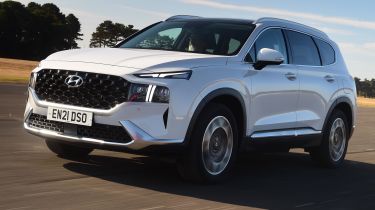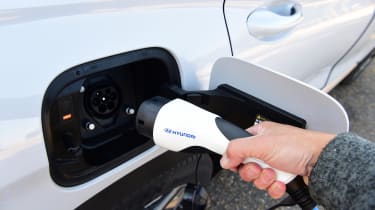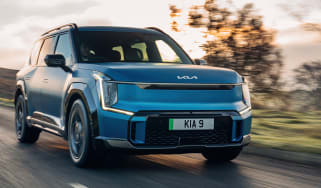Hyundai Santa Fe Plug-In review
Plug-in hybrid power keeps the running costs of this spacious seven-seater SUV as low as possible, but the driving experience leaves something to be desired

Pros
- Very spacious
- Well thought-out interior
- Seats seven while still fitting battery
Cons
- Not very elegant-looking
- Ride comfort could be better
- Slower than power output suggests
| Car type | Electric range | Fuel economy | CO2 emissions |
|---|---|---|---|
| Plug-in hybrid | 36 miles | 174mpg | 37g/km |
Hyundai was one of the first big carmakers to offer a wide choice of electrified powertrains in one model, launching the Ioniq hatchback with either hybrid, plug-in hybrid or fully electric power. This practice has now become commonplace for both Hyundai and other brands, so it's unsurprising to find you can have the latest version of its big Santa Fe seven-seater SUV with plug-in or non-plug-in hybrid hardware under the bonnet.
You can read our review of the non-plug-in Santa Fe hybrid here, but if you're interested in the plug-in hybrid version, with a larger battery for a claimed 36-mile electric range, then keep reading. One of its chief selling points over rivals is that it retains its practical seven-seat layout while also accommodating that bigger battery – not something all plug-in hybrid SUVs manage to do.
On the outside, there's little to distinguish the two Santa Fes: the plug-in gets the same imposing and rather boxy styling as its hybrid sibling. It's not as sharp and elegant-looking as the smaller and cheaper Hyundai Tucson, but there are some attractive touches here and there. What the plug-in does have that the regular hybrid doesn't is a second 'fuel cap' on the opposite side that actually gives access to the charging port.
This is where you plug in a charging cable to top up the Santa Fe's 13.8kWh battery. Doing so is essential if you hope to hit the lofty claimed figures of nearly 174mpg fuel economy and 37g/km CO2 emissions; like any plug-in hybrid, the Santa Fe doesn't make a lot of sense if you don't have access to a home or workplace charging point to juice up the battery overnight or during the day.
Presuming you do, you should be able to cover an average daily commute on battery power only, resorting to the petrol engine only on longer motorway trips. Driving with the battery depleted results in a miles-per-gallon figure in the mid-30s, which really isn't too bad for a large petrol-engined SUV.
And you'll probably be glad not to have to call on the petrol engine too often, as when it does spring into life, it's a little louder and harsher-sounding than would be ideal. The combined petrol-and-electric power output of 261bhp looks impressive on paper, but in reality the car doesn't feel that quick: the official 0-62mph time is 8.8 seconds and Hyundai's six-speed automatic transmission is far from the quickest-witted we've tried.
In general, the Santa Fe responds best to a relaxed and unhurried driving style – both because of that hesitant gearbox and the fact that it's not as smooth and composed over poorer-quality road surfaces as some of its rivals. The ride can be fidgety, especially at higher speeds, and you'll feel a jolt over a big bump or pothole.
So the Santa Fe isn't the best large family SUV to drive, but it does acquit itself well when it comes to practicality – among the biggest priorities for large family SUV buyers. Even with the panoramic sunroof fitted to the top-spec Ultimate model, there's masses of headroom in all three rows and adults will be just as comfortable in the second row as they are seated up front.
That second row can slide back and forth, letting you prioritise boot or passenger space as needed and also flips forward at the push of a button, making access to the third row (which is on the tight side for adults, but will be fine for kids) easier. Cabin storage is pretty good too, although the door bins are shallower than we'd like.

Choosing which Santa Fe to buy is straightforward, as there are just two trim levels: Premium and Ultimate. As the names suggest, both are well equipped, with even the cheaper Premium packing features such as 19-inch alloy wheels; roof rails; heated and power-adjustable front seats; full LED headlights and tail-lights; 12v power outlets in the first row, second row and boot; adaptive cruise control; power-folding heated mirrors; a heated steering wheel; USB ports front and rear; wireless charging and full smartphone connectivity.
Ultimate spec adds a blind-spot monitor, a parking collision avoidance system, remote parking assistance, a 360-degree 'Surround View Monitor', rear door blinds, ventilation for the front seats, a head-up display, a larger driver's display screen and a tilting-and-sliding panoramic glass sunroof.
Overall, the Santa Fe Plug-In Hybrid ticks a lot of important boxes for those in the market for a large, practical, well equipped and cheap-to-run seven-seat family car. But it loses out to some similarly priced rivals from more upmarket brands, such as the Audi Q5 and Volvo XC60 hybrids, when it comes to the driving experience – in terms of power and handling as well as comfort and refinement. Although those two cars are five-seaters, depending on how important those areas are to you, they might be more appealing.




